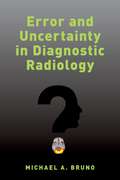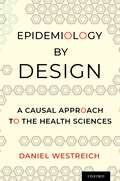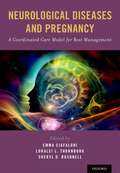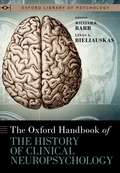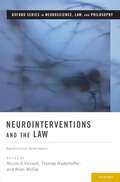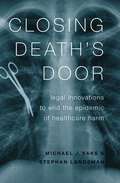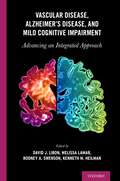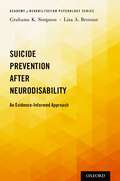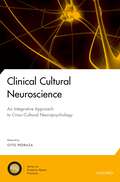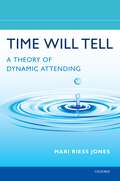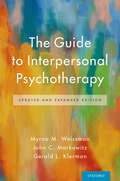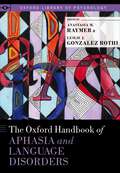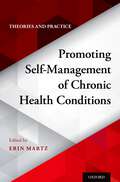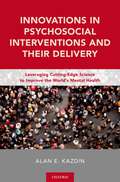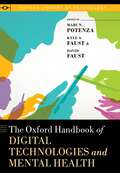- Table View
- List View
Error and Uncertainty in Diagnostic Radiology
by Michael A. BrunoOver the past decade, radiological imaging tests - including CT scanning, MRI, PET, X-rays, ultrasound, fluoroscopy and other modalities - have become essential to the routine diagnostic process. While these modern advanced medical images and their striking anatomic detail have discovered underlying issues, they have also contributed to a false impression of infallibility. Unlike other straightforward diagnostic tests, such as the EKG or blood chemistry panel, radiological imaging tests are highly variable and complex, often yielding uncertain results, as well as frequent false-negatives and false-positives. The experts who interpret the images (the diagnostic radiologists) sometimes make mistakes: the practice of diagnostic radiology is a fallible, human endeavour, one involving complex perceptual, neuro-physiological and cognitive processes employed under a wide range of circumstances, and with a great deal of variability. Error and Uncertainty in Diagnostic Radiology opens the 'black box,' of medical imaging, exposing the remarkable inner workings of the process of diagnostic radiology-including how and why it can sometimes go tragically wrong. The occurrence of radiological error is shown to be fundamentally intertwined with the underlying high level of uncertainty known to be present in the diagnostic process. As a foremost expert on radiology quality and safety, Dr. Bruno provides insight into the various types of radiologist error, along with a conceptual framework for understanding error and uncertainty in radiology, leading to practical strategies for error prevention and for reducing the risk of harm to patients when errors inevitably occur. This book is essential for radiologists, members of the Society to Improve Diagnosis in Medicine, emergency physicians, medical educators, medical and hospice administrators, especially quality and safety officers, as well as malpractice insurance carriers.
Error and Uncertainty in Diagnostic Radiology
by Michael A. BrunoOver the past decade, radiological imaging tests - including CT scanning, MRI, PET, X-rays, ultrasound, fluoroscopy and other modalities - have become essential to the routine diagnostic process. While these modern advanced medical images and their striking anatomic detail have discovered underlying issues, they have also contributed to a false impression of infallibility. Unlike other straightforward diagnostic tests, such as the EKG or blood chemistry panel, radiological imaging tests are highly variable and complex, often yielding uncertain results, as well as frequent false-negatives and false-positives. The experts who interpret the images (the diagnostic radiologists) sometimes make mistakes: the practice of diagnostic radiology is a fallible, human endeavour, one involving complex perceptual, neuro-physiological and cognitive processes employed under a wide range of circumstances, and with a great deal of variability. Error and Uncertainty in Diagnostic Radiology opens the 'black box,' of medical imaging, exposing the remarkable inner workings of the process of diagnostic radiology-including how and why it can sometimes go tragically wrong. The occurrence of radiological error is shown to be fundamentally intertwined with the underlying high level of uncertainty known to be present in the diagnostic process. As a foremost expert on radiology quality and safety, Dr. Bruno provides insight into the various types of radiologist error, along with a conceptual framework for understanding error and uncertainty in radiology, leading to practical strategies for error prevention and for reducing the risk of harm to patients when errors inevitably occur. This book is essential for radiologists, members of the Society to Improve Diagnosis in Medicine, emergency physicians, medical educators, medical and hospice administrators, especially quality and safety officers, as well as malpractice insurance carriers.
Epidemiology by Design: A Causal Approach to the Health Sciences
by Daniel WestreichA (LONG OVERDUE) CAUSAL APPROACH TO INTRODUCTORY EPIDEMIOLOGY Epidemiology is recognized as the science of public health, evidence-based medicine, and comparative effectiveness research. Causal inference is the theoretical foundation underlying all of the above. No introduction to epidemiology is complete without extensive discussion of causal inference; what's missing is a textbook that takes such an approach. Epidemiology by Design takes a causal approach to the foundations of traditional introductory epidemiology. Through an organizing principle of study designs, it teaches epidemiology through modern causal inference approaches, including potential outcomes, counterfactuals, and causal identification conditions. Coverage in this textbook includes: · Introduction to measures of prevalence and incidence (survival curves, risks, rates, odds) and measures of contrast (differences, ratios); the fundamentals of causal inference; and principles of diagnostic testing, screening, and surveillance · Description of three key study designs through the lens of causal inference: randomized trials, prospective observational cohort studies, and case-control studies · Discussion of internal validity (within a sample), external validity, and population impact: the foundations of an epidemiologic approach to implementation science For first-year graduate students and advanced undergraduates in epidemiology and public health fields more broadly, Epidemiology by Design offers a rigorous foundation in epidemiologic methods and an introduction to methods and thinking in causal inference. This new textbook will serve as a foundation not just for further study of the field, but as a head start on where the field is going.
Epidemiology by Design: A Causal Approach to the Health Sciences
by Daniel WestreichA (LONG OVERDUE) CAUSAL APPROACH TO INTRODUCTORY EPIDEMIOLOGY Epidemiology is recognized as the science of public health, evidence-based medicine, and comparative effectiveness research. Causal inference is the theoretical foundation underlying all of the above. No introduction to epidemiology is complete without extensive discussion of causal inference; what's missing is a textbook that takes such an approach. Epidemiology by Design takes a causal approach to the foundations of traditional introductory epidemiology. Through an organizing principle of study designs, it teaches epidemiology through modern causal inference approaches, including potential outcomes, counterfactuals, and causal identification conditions. Coverage in this textbook includes: · Introduction to measures of prevalence and incidence (survival curves, risks, rates, odds) and measures of contrast (differences, ratios); the fundamentals of causal inference; and principles of diagnostic testing, screening, and surveillance · Description of three key study designs through the lens of causal inference: randomized trials, prospective observational cohort studies, and case-control studies · Discussion of internal validity (within a sample), external validity, and population impact: the foundations of an epidemiologic approach to implementation science For first-year graduate students and advanced undergraduates in epidemiology and public health fields more broadly, Epidemiology by Design offers a rigorous foundation in epidemiologic methods and an introduction to methods and thinking in causal inference. This new textbook will serve as a foundation not just for further study of the field, but as a head start on where the field is going.
Methods in Bioethics: The Way We Reason Now
by John ArrasThis book provides an overview and critical discussion of the main philosophical methods that have dominated the field of bioethics since its origins in the late 1960s and early 1970s. The first three chapters outline some influential theories that are important to understanding the methodological approaches that follow. Chapter 1 offers a survey of the theory of principlism as expounded by Tom Beauchamp and James Childress, Chapter 2 examines Bernard Gert's defense of common morality, and Chapter 3 discusses the so-called "new casuistry." The next three chapters trace a historical dialectic. Chapter 4 explores the shift that has increasingly occurred in bioethics away from the pursuit of objectivity or truth and towards narrative ethics, while Chapter 5 uncovers the "classical" roots of American pragmatism and explains their on-going relevance for contemporary bioethics. This paves the way for Chapter 6's examination of "freestanding" pragmatists such as Susan Wolf who, in contrast, see their approach as untethered to the classical canon of American pragmatism. With this background firmly established, the next two chapters handle some influential contemporary approaches. Chapter 7 considers the "internal morality" approach to medicine; chapter 8 discusses the method of reflective equilibrium. Chapter 9 summarizes and reflects on the results of the preceding eight chapters. Rather than staking out and defending a final position, the book aspires to uncover the advantages and disadvantages of the different methodological approaches. In the words of Kierkegaard, it aims to make life "harder" rather than "easier" for bioethics by uncovering some outstanding challenges.
Methods in Bioethics: The Way We Reason Now
by John ArrasThis book provides an overview and critical discussion of the main philosophical methods that have dominated the field of bioethics since its origins in the late 1960s and early 1970s. The first three chapters outline some influential theories that are important to understanding the methodological approaches that follow. Chapter 1 offers a survey of the theory of principlism as expounded by Tom Beauchamp and James Childress, Chapter 2 examines Bernard Gert's defense of common morality, and Chapter 3 discusses the so-called "new casuistry." The next three chapters trace a historical dialectic. Chapter 4 explores the shift that has increasingly occurred in bioethics away from the pursuit of objectivity or truth and towards narrative ethics, while Chapter 5 uncovers the "classical" roots of American pragmatism and explains their on-going relevance for contemporary bioethics. This paves the way for Chapter 6's examination of "freestanding" pragmatists such as Susan Wolf who, in contrast, see their approach as untethered to the classical canon of American pragmatism. With this background firmly established, the next two chapters handle some influential contemporary approaches. Chapter 7 considers the "internal morality" approach to medicine; chapter 8 discusses the method of reflective equilibrium. Chapter 9 summarizes and reflects on the results of the preceding eight chapters. Rather than staking out and defending a final position, the book aspires to uncover the advantages and disadvantages of the different methodological approaches. In the words of Kierkegaard, it aims to make life "harder" rather than "easier" for bioethics by uncovering some outstanding challenges.
Neurological Diseases and Pregnancy: A Coordinated Care Model for Best Management
For a woman of reproductive age, any medical appointment is a pre-conception visit and an opportunity to address pre-existing conditions that affect pregnancy and the maternal-fetal dyad. However, many neurologic conditions are rarely seen in pregnancy, and limited experience and knowledge may prevent the team from developing a shared approach to these complex conditions during pregnancy. Neurological Diseases and Pregnancy: A Coordinated Care Model for Best Management brings together experts across the disciplines of maternal fetal medicine, neurology, obstetrics, family planning, genetics, anesthesia, psychiatry, neurosurgery, and lactation to provide a multi-disciplinary, comprehensive, protocol-driven guide on best care for patients with neurologic disease before, during and after pregnancy. Each chapter provides a detailed care map on each unique disorder, and discusses the use of neurological medications during pregnancy and in lactation. Through this multi-disciplinary approach clinicians can navigate the complexities of preconception and pregnancy care, and help to optimize outcomes for the mother-infant dyad. Beyond pregnancy care, this volume further serves as a resource on best care for the life-course of women affected by neurologic disease including pre-pregnancy planning, genetic counseling, contraception, and sexuality in neurologic disease, as well as post-partum depression and menopausal neurologic changes.
Neurological Diseases and Pregnancy: A Coordinated Care Model for Best Management
by Emma Ciafaloni, MD, Faan, Loralei L. Thornburg, MD and Cheryl D. Bushnell, MD, MHSFor a woman of reproductive age, any medical appointment is a pre-conception visit and an opportunity to address pre-existing conditions that affect pregnancy and the maternal-fetal dyad. However, many neurologic conditions are rarely seen in pregnancy, and limited experience and knowledge may prevent the team from developing a shared approach to these complex conditions during pregnancy. Neurological Diseases and Pregnancy: A Coordinated Care Model for Best Management brings together experts across the disciplines of maternal fetal medicine, neurology, obstetrics, family planning, genetics, anesthesia, psychiatry, neurosurgery, and lactation to provide a multi-disciplinary, comprehensive, protocol-driven guide on best care for patients with neurologic disease before, during and after pregnancy. Each chapter provides a detailed care map on each unique disorder, and discusses the use of neurological medications during pregnancy and in lactation. Through this multi-disciplinary approach clinicians can navigate the complexities of preconception and pregnancy care, and help to optimize outcomes for the mother-infant dyad. Beyond pregnancy care, this volume further serves as a resource on best care for the life-course of women affected by neurologic disease including pre-pregnancy planning, genetic counseling, contraception, and sexuality in neurologic disease, as well as post-partum depression and menopausal neurologic changes.
The Oxford Handbook of the History of Clinical Neuropsychology (Oxford Library of Psychology)
While its origins date back to the 19th Century, the field of clinical neuropsychology has existed as a distinct discipline for less than 60 years. The Oxford Handbook of the History of Neuropsychology tells this story of how neuropsychology has evolved to its present state and where is it going. This comprehensive volume begins with chapters reviewing the history of neuropsychology's approaches to disorders of attention, language, memory, and other conditions. Other chapters focus on the origins of neuropsychology's methods including neuropsychological testing, brain imaging, and studies of laterality including the Wada test. While this volume has a number of chapters covering regional developments in clinical neuropsychology as a profession in the United States, it is one of the first volumes to provide additional chapters on development of neuropsychology across different countries. This Handbook gathers the work of experts in the field to provide extensive coverage of the origins of neuropsychology's methods and its approach to various clinical conditions across the globe.
The Oxford Handbook of the History of Clinical Neuropsychology (Oxford Library of Psychology)
by William B. Barr and Linas A. BieliauskasWhile its origins date back to the 19th Century, the field of clinical neuropsychology has existed as a distinct discipline for less than 60 years. The Oxford Handbook of the History of Neuropsychology tells this story of how neuropsychology has evolved to its present state and where is it going. This comprehensive volume begins with chapters reviewing the history of neuropsychology's approaches to disorders of attention, language, memory, and other conditions. Other chapters focus on the origins of neuropsychology's methods including neuropsychological testing, brain imaging, and studies of laterality including the Wada test. While this volume has a number of chapters covering regional developments in clinical neuropsychology as a profession in the United States, it is one of the first volumes to provide additional chapters on development of neuropsychology across different countries. This Handbook gathers the work of experts in the field to provide extensive coverage of the origins of neuropsychology's methods and its approach to various clinical conditions across the globe.
Neurointerventions and the Law: Regulating Human Mental Capacity (Oxford Series in Neuroscience, Law, and Philosophy)
by Nicole A Vincent, Thomas Nadelhoffer and Allan MccayThis volume makes a contribution to the field of neurolaw by investigating issues raised by the development, use, and regulation of neurointerventions. The broad range of topics covered in these chapters reflects neurolaw's growing social import, and its rapid expansion as an academic field of inquiry. Some authors investigate the criminal justice system's use of neurointerventions to make accused defendants fit for trial, to help reform convicted offenders, or to make condemned inmates sane enough for execution, while others interrogate the use, regulation, and social impact of cognitive enhancement medications and devices. Issues raised by neurointervention-based gay conversion "therapy", efficacy and safety of specific neurointervention methods, legitimacy of their use and regulation, and their implications for authenticity, identity, and responsibility are among the other topics investigated. Dwelling on neurointerventions also highlights tacit assumptions about human nature that have important implications for jurisprudence. For all we know, at present such things as people's capacity to feel pain, their sexuality, and the dictates of their conscience, are unalterable. But neurointerventions could hypothetically turn such constants into variables. The increasing malleability of human nature means that analytic jurisprudential claims (true in virtue of meanings of jurisprudential concepts) must be distinguished from synthetic jurisprudential claims (contingent on what humans are actually like). Looking at the law through the lens of neurointerventions thus also highlights the growing need for a new distinction between analytic jurisprudence and synthetic jurisprudence to tackle issues that increasingly malleable humans will face when they encounter novel opportunities and challenges.
Closing Death's Door: Legal Innovations to End the Epidemic of Healthcare Harm
by Michael J. Saks Stephan LandsmanAfter heart disease and cancer, the third leading cause of death in the United States is iatrogenic injury (avoidable injury or infection caused by a healer). Research suggests that avoidable errors claim several hundred thousand lives every year. The principal economic counterforce to such errors, malpractice litigation, has never been a particularly effective deterrent for a host of reasons, with fewer than 3% of negligently injured patients (or their families) receiving any compensation from a doctor or hospital's insurer. Closing Death's Door brings the psychology of decision making together with the law to explore ways to improve patient safety and reduce iatrogenic injury, when neither the healthcare industry itself nor the legal system has made a substantial dent in the problem. Beginning with an unflinching introduction to the problem of patient safety, the authors go on to define iatrogenic injury and its scope, shedding light on the culture and structure of a healthcare industry that has failed to effectively address the problem-and indeed that has influenced legislation to weaken existing legal protections and impede the adoption of potentially promising reforms. Examining the weak points in existing systems with an eye to using law to more effectively bring about improvement, the authors conclude by offering a set of ideas intended to start a conversation that will lead to new legal policies that lower the risk of harm to patients. Closing Death's Door is brought to vivid life by the stories of individuals and groups that have played leading roles in the nation's struggle with iatrogenic injury, and is essential reading for medical and legal professionals, as well as lawmakers and laypeople with an interest in healthcare policy.
Closing Death's Door: Legal Innovations to End the Epidemic of Healthcare Harm
by Stephan Landsman Michael J. SaksAfter heart disease and cancer, the third leading cause of death in the United States is iatrogenic injury (avoidable injury or infection caused by a healer). Research suggests that avoidable errors claim several hundred thousand lives every year. The principal economic counterforce to such errors, malpractice litigation, has never been a particularly effective deterrent for a host of reasons, with fewer than 3% of negligently injured patients (or their families) receiving any compensation from a doctor or hospital's insurer. Closing Death's Door brings the psychology of decision making together with the law to explore ways to improve patient safety and reduce iatrogenic injury, when neither the healthcare industry itself nor the legal system has made a substantial dent in the problem. Beginning with an unflinching introduction to the problem of patient safety, the authors go on to define iatrogenic injury and its scope, shedding light on the culture and structure of a healthcare industry that has failed to effectively address the problem-and indeed that has influenced legislation to weaken existing legal protections and impede the adoption of potentially promising reforms. Examining the weak points in existing systems with an eye to using law to more effectively bring about improvement, the authors conclude by offering a set of ideas intended to start a conversation that will lead to new legal policies that lower the risk of harm to patients. Closing Death's Door is brought to vivid life by the stories of individuals and groups that have played leading roles in the nation's struggle with iatrogenic injury, and is essential reading for medical and legal professionals, as well as lawmakers and laypeople with an interest in healthcare policy.
Vascular Disease, Alzheimer's Disease, and Mild Cognitive Impairment: Advancing an Integrated Approach
by David J. Libon, Melissa Lamar, Rodney A. Swenson, and Kenneth M. HeilmanAlzheimer's disease (AD) and vascular dementia (VaD) are commonly viewed as the first and second most common types of dementia, respectively. The traditional paradigm has been to view and treat each illness as a separate entity with a separate pathophysiology. However, clinical and pathological studies suggest that the boundary separating AD and VaD, as well as their mild cognitive impairment (MCI) analogs, is not well defined. Thus, there is increased interest in viewing these diseases along a spectrum because of the significant overlap in the characterization and diagnosis of AD, VaD, and MCI. The focus of this edited volume is to examine how AD and VaD, as well as their MCI analogs, are best viewed as a heterogeneous, intersecting, if not a continuous disease state rather than separate, distinct entities. This book examines this approach by providing empirically based evidence, reviews of the literature, and chapters by key leaders in the field and will be of interest to clinical neuropsychologists and anyone studying or treating dementia in its many forms.
Suicide Prevention After Neurodisability: An Evidence-Informed Approach (Academy of Rehabilitation Psychology Series)
by Grahame K. Simpson Lisa A. BrennerSuicide risk after disabling neurological conditions is up to five times higher than for the general population; however, knowledge about the extent of the problem, associated risk factors, and effective evidence-informed suicide prevention approaches are limited and fragmented. Suicide Prevention after Neurodisability focuses on the challenges faced by eight different types of neurodisability, namely stroke, spinal cord injury, traumatic brain injury, amyotrophic lateral sclerosis, epilepsy, Huntington's disease, multiple sclerosis, and Parkinson's disease. It pulls together the current knowledge about this risk, detailing a complex interplay between neuropathological, psychiatric, psychological, and psychosocial factors that in part account for this increased presence of suicidal thoughts and behaviors. Despite the challenges, suicide is often preventable. The best available evidence-informed approaches to suicide prevention in neurodisability are outlined, including clinical approaches to screening, suicide risk assessment, psychotherapeutic interventions, and psychosocial management. The reader-friendly approach will help make suicide prevention after neurodisability everyone's business.
Suicide Prevention After Neurodisability: An Evidence-Informed Approach (Academy of Rehabilitation Psychology Series)
by Grahame K. Simpson Lisa A. BrennerSuicide risk after disabling neurological conditions is up to five times higher than for the general population; however, knowledge about the extent of the problem, associated risk factors, and effective evidence-informed suicide prevention approaches are limited and fragmented. Suicide Prevention after Neurodisability focuses on the challenges faced by eight different types of neurodisability, namely stroke, spinal cord injury, traumatic brain injury, amyotrophic lateral sclerosis, epilepsy, Huntington's disease, multiple sclerosis, and Parkinson's disease. It pulls together the current knowledge about this risk, detailing a complex interplay between neuropathological, psychiatric, psychological, and psychosocial factors that in part account for this increased presence of suicidal thoughts and behaviors. Despite the challenges, suicide is often preventable. The best available evidence-informed approaches to suicide prevention in neurodisability are outlined, including clinical approaches to screening, suicide risk assessment, psychotherapeutic interventions, and psychosocial management. The reader-friendly approach will help make suicide prevention after neurodisability everyone's business.
Clinical Cultural Neuroscience: An Integrative Approach to Cross-Cultural Neuropsychology (National Academy of Neuropsychology: Series on Evidence-Based Practices)
by Otto PedrazaClinical Cultural Neuroscience aims to provide clinicians and researchers with an overview of contemporary topics relevant to the study of culture in psychology and neuroscience. Within a translational thematic framework, this multidisciplinary volume surveys our current understanding of human behavior and culture along the spectrum of health and disease across multiple levels of analysis, from molecular genetics to sociocultural environment.
Time Will Tell: A Theory of Dynamic Attending
by Mari Riess JonesAttention is a central concept in psychology. The term 'attention' itself has persisted, even though it implies a static, insulated capacity that we use when it is necessary to focus upon some relevant or stimulating event. Riess Jones presents a different way of thinking about attention; one that describes it as a continuous activity that is based on energy fluctuating in time. A majority of attention research fails to examine influence of event time structure (i.e., a speech utterance) on listeners' moment-to-moment attending. General research ignores listeners endowed with innate, as well as acquired, temporal biases. Here, attending is portrayed as a dynamic interaction of an individual within his or her surroundings. Importantly, this interaction involves synchronicity between an attender and external events. This emphasis on time and synchronicity distinguishes the author's theory, called Dynamic Attending Theory (DAT), from other approaches to attending which characterize attention metaphorically as a filter, resource pool, spotlight, and so on. Recent research from neuroscience has lent support to Riess Jones' theory, and the goal of this book is to bring this new research as well as her own to the wide audience of psychologists interested in attention more broadly.
Personalized Exposure Therapy: A Person-Centered Transdiagnostic Approach
by Michael W. Otto Mark B. Powers Jasper A.J. SmitsEvidence overwhelmingly shows that exposure therapy is effective for the treatment of anxiety and related disorders. Its adoption into clinical practice has been slow, however-in part because the available one-size-fits-all manuals often leave patients and clinicians unsatisfied. Personalized Exposure Therapy provides expert guidance to clinicians on conducting exposure-based interventions in a targeted and flexible fashion. Providing detailed information on a range of strategies for maximizing clinical outcomes from exposure, this book features a case formulation approach that personalizes the timing and nature of exposure practice. Case examples, scripts, and worksheets, presented in a practical, mentor-based format for planning and enacting individual sessions, ensure that clinical procedures are readily accessible for in-session use. Personalized Exposure Therapy is appropriate for early-career and experienced clinicians alike, and will also be suitable for use in graduate courses in clinical psychology, counselling, social work, nursing and psychiatry.
The Guide to Interpersonal Psychotherapy: Updated and Expanded Edition
by Myrna M. Weissman John C. Markowitz Gerald L. KlermanThe Guide to Interpersonal Psychotherapy is the definitive, practical guide to Interpersonal Psychotherapy (IPT) for clinicians and researchers. IPT is a well-researched, time-limited, and diagnosis-focused therapy. An update and expansion of the original 1984, 2000, and 2007 IPT manuals, this guide illustrates not only individual IPT treatment for patients with major depression but also adaptations of IPT for different diagnoses, patient populations, and treatment formats. This book is the basis for the extensive research that has validated IPT and led to its listing in treatment guidelines. Written by the originators of the treatment and one of its leading researchers, this updated and expanded guide describes how to approach clinical encounters with patients, how to focus IPT treatment, and how to handle therapeutic difficulties. IPT can be combined with medication, and it is a safe alternative to medication for individuals who may not be able to take antidepressants. IPT has been shown not only to relieve symptoms but to build social skills as well. Learn how to use IPT to effectively treat depression and other disorders including bipolar disorder, anxiety disorders, eating disorders, posttraumatic stress, and borderline personality disorder. With clinical examples and sample therapist scripts throughout, The Guide summarizes the theoretical and empirical background of IPT and focuses on teaching you the best way to deliver this effective, immensely practical treatment.
The Oxford Handbook of Aphasia and Language Disorders (Oxford Library of Psychology)
by Leslie J. Gonzalez Rothi Anastasia M. RaymerWhat is immediately clear when meeting individuals with acquired brain damage is that the patterns of communication impairments vary in remarkable ways among these individuals. Aphasia and related communication disorders, while devastating life events for individuals who acquire brain damage, provide lessons of considerable interest to many clinicians and researchers trying to understand the brain's neurological and psychological complexity and develop methods to facilitate optimum recovery of lost language and communication functions following brain damage. The Oxford Handbook of Aphasia and Language Disorders weaves theoretical and neurological foundations with rational, motivated clinical approaches to assessment, diagnosis, and intervention for aphasia and related communication disorders. The contributing authors, experienced clinicians and scientists with strong backgrounds in neurological and cognitive neuropsychological theories, bridge theory to clinical practice, reviewing the extant literature in each aphasia syndrome while exploring implications for guiding clinical decision-making. Introductory chapters provide historical perspectives on the aphasia syndromes following left hemisphere brain damage, and review aphasia assessment across the decades. The bulk of the Handbook covers aphasia syndromes, with chapters that describe each aphasia syndrome in detail, including behavioral, neural, and cognitive neuropsychological correlates and methods to assess and treat each syndrome. Additional chapters provide insights into acquired reading and writing disorders and social and prosodic communication disorders that follow damage to the right cerebral hemisphere. The final chapters examine neural perspectives on aphasia recovery and principles of neuroplasticity in aphasia treatment. As such, this book integrates neural, cognitive, and clinical perspectives to provide a broad understanding of the complexity of language and impairments that can arise following acquired brain damage, and will be of interest to scholars and clinicians in the speech-language, neuropsychology, and rehabilitation professions.
Coming of Age: The Neurobiology and Psychobiology of Puberty and Adolescence
by Cheryl L. Sisk Russell D. RomeoContemporary neuroscience has made remarkable strides in our understanding of the developing adolescent brain--an area of study previously reserved for developmental psychologists and pediatric endocrinologists. With an eye toward the history and future of the field, Coming of Age takes a look at the research that brought about this paradigm shift. Current advances in neuroscience have changed the way we think about everything--from how drugs and stress influence adolescent development to how hormones cause differing developmental trajectories among females and males. Sisk and Romeo guide students and non-specialist researchers alike through the basic science of brain and behavioral development. Important social and ethical questions are raised including: Why does puberty continue to occur at a younger age? Why does teenage behavior embrace risk and volatility? When does adolescent development end? And how should our understanding of adolescent development affect the juvenile justice system?
Promoting Self-Management of Chronic Health Conditions: Theories and Practice
by Erin MartzIt is common for a doctor or healthcare professional to see an individual with a chronic health condition only a few times a year for a brief office appointment. Yet, the individual has to live with the health condition 24 hours a day, 7 days a week. So, who really is in charge of managing the health condition? The individual has to "micro-manage" their condition, while healthcare professionals can provide advice on treatment approaches or the "macro-management" of the chronic health condition. Promoting Self-Management of Chronic Health Conditions covers a range of topics related to self-management-theories and practice, interventions that have been scientifically tested, and information that individuals with specific conditions should know (or be taught by healthcare professionals). Data suggest that currently a majority of individuals in the U.S. has a chronic health condition, and as society ages and healthcare continues to improve individuals' life-spans, more people will experience a chronic health condition. Health systems need to shift from an acute care model of treatment to a chronic care treatment model, in view of this trend. The expanding need for the development and scientific analysis of formal self-management programs accompany this increase in chronic health conditions. This book serves the critical purpose of helping to increase understanding of self-management and how healthcare providers can empower individuals with chronic health conditions to self-manage.
Innovations in Psychosocial Interventions and Their Delivery: Leveraging Cutting-Edge Science to Improve the World's Mental Health
by Alan E. KazdinMillions of children, adolescents, and adults worldwide experience significant mental health problems, for which they receive no treatment whatsoever. Despite decades of world-class, innovative treatment research, growing governmental and public attention to mental health issues, and decreasing stigma around seeking care, the supply of tools and resources available to combat the burdens of mental illness globally are vastly outweighed by demand for services. Innovations in Psychosocial Interventions and Their Delivery provides an integrated and detailed overview of advances, challenges, and necessary new directions with regard to evidence-based psychological interventions. Drawing on diverse fields such as public health, business, entertainment, social policy and law, and other domains that may inform efforts to deliver interventions more effectively, Alan Kazdin explores an assortment of novel and inventive ways to address the world's mental health crisis. Focusing attention on promising scientific developments and the special challenges that emerge in evaluating and delivering such interventions, the book examines opportunities such as trans-diagnostic treatments, inventive uses of technology, complementary approaches, novel methods of dissemination such as task-shifting, and more. The first to bring together such diverse perspectives in an effort to show precisely and practically how treatments could be delivered effectively and in a scalable manner, Innovations in Psychosocial Interventions and Their Delivery has direct and immediate implications for health care systems but also for research and clinical practice in the mental health professions. It will be of keen interest to those in psychology, psychiatry, social work, family studies, counseling, nursing, and healthcare administration.
The Oxford Handbook of Digital Technologies and Mental Health (Oxford Library of Psychology)
by Marc N. Potenza David Faust Kyle FaustDigital technology use, whether on smartphones, tablets, laptops, or other devices, is prevalent across cultures. Certain types and patterns of digital technology use have been associated with mental health concerns, but these technologies also have the potential to improve mental health through the gathering of information, by targeting interventions, and through delivery of care to remote areas. The Oxford Handbook of Digital Technologies and Mental Health provides a comprehensive and authoritative review of the relationships between mental health and digital technology use, including how such technologies may be harnessed to improve mental health. Understanding the positive and negative correlates of the use of digital technologies has significant personal and public health implications, and as such this volume explores in unparalleled depth the historical and cultural contexts in which technology use has evolved; conceptual issues surrounding digital technologies; potential positive and potential negative impacts of such use; treatment, assessment, and legal considerations around digital technologies and mental health; technology use in specific populations; the use of digital technologies to treat psychosocial disorders; and the treatment of problematic internet use and gaming. With chapters contributed by leading scientists from around the world, this Handbook will be of interest to those in medical and university settings, students and clinicians, and policymakers.
